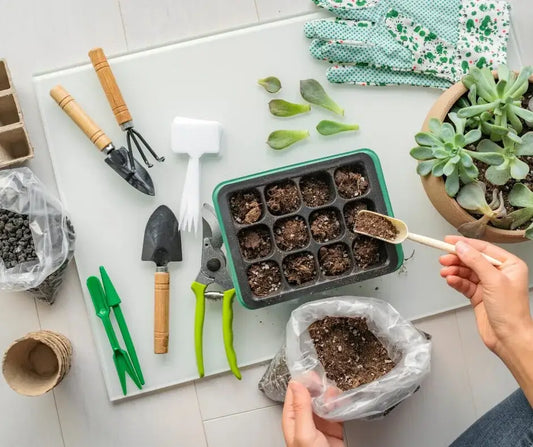
So, you successfully whisked all your houseplants safely inside ahead of the Big Bad Chill. And as usual, it was a frantic race against Jack Frost. Now what? Well, if you’re anything like the average over-extended gardener with good intentions but limited time, you probably ran those babies indoors last minute. In other words, you might have skipped the repotting sequence. Or maybe, while schlepping, you intentionally decided to maintain the status quo for pot sizes rather than graduating a plant into a larger (heavier) container. We get it. And there are solutions for “What’s Next?” that don’t entail adding to the weight of your work.
Repotting Alternatives

Just guessing that some of your plants had probably filled their current container when you brought them indoors. In other words, if you checked the root system, healthy roots would be visible around the edges of the soil, winding around. Sure, they could be graduated into a new, larger container. And that might be optimal, especially if the root system has completely filled the pot. But maybe you don’t have space for a bigger footprint in your home. Or perhaps you don’t want to lug a larger plant around. Or maybe you just love the decorative container that you matched the plant up with and would like to enjoy the combo for another year. There are solutions. Another method of delivering more food to your plants is to supply a shot of fertilizer. Dilute and serve Coast of Maine’s Liquid Squid Concentrate Fertilizer for Indoor Plants to supply the boost your hungry houseplants crave. Another solution is to sprinkle some Coast of Maine Stonington Blend Plant Food on top of the soil according to the package directions. That way, you’ll be supplying the nourishment your plant needs without adding poundage to the pot. Another alternative to deliver an energy boost is to sprinkle some soil-conditioning Wiscasset Blend Organic Earthworm Castings on top of the soil according to the directions on the bag.

The Last Supper
Meanwhile, autumn signals the start of shorter daylight, and that shift affects your houseplants as well as the cycles outdoors. Most houseplants slip into less active growth when the days shorten. While they’re resting and not making active growth, it’s wise to withhold fertilizer. You still have time to give your plants a couple of meals to get them ready for winter. So, give the whole green family a shot of fertilizer now and again in a few weeks.

Thanksgiving is usually the cut off time to serve a last seasonal feast for your houseplants. For that last serving, dilute the fertilizer a little more than usual to ease into a slower time. And then continue watering your houseplants with tap water when their root systems are dry during the winter months, keeping in mind that on frigid days, your furnace might kick on more readily than usual, resulting in soil that dries out more often. So, while admiring the beauty of your houseplants, keep an eye on the soil to make sure the plants aren’t dry.

Hungry Hearts
Of course, all rules have their exceptions and some houseplants have hungry hearts. Citrus, stephanotis, and winter-blooming jasmine (Jasminum polyanthum) all prefer non-stop feeding throughout the winter. So keep them happy by fertilizing throughout winter. And all your houseplants will appreciate a good meal when the light levels increase from March 1st onward. So be sure to have your fertilizer ready and on hand for that feast. Meanwhile, enjoy the plants in your home and increase the collection. Houseplants are going to get you through winter. And absolutely, if you adopt a new plant into your home over winter, give it a great container to make that new family member shine. Don’t go crazy with a much larger pot, but be ready to graduate the pot size if necessary when spring rolls around again. It’s all part of playing the good host to every living thing under your care. The good news is that you reap all the beautiful results.
Written by award winning author, Tovah Martin. Photos also taken by Tovah Martin. Find her books and more information on her website: tovahmartin.com.













